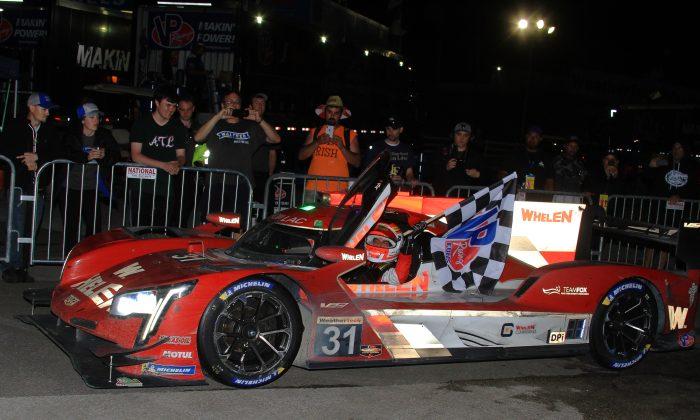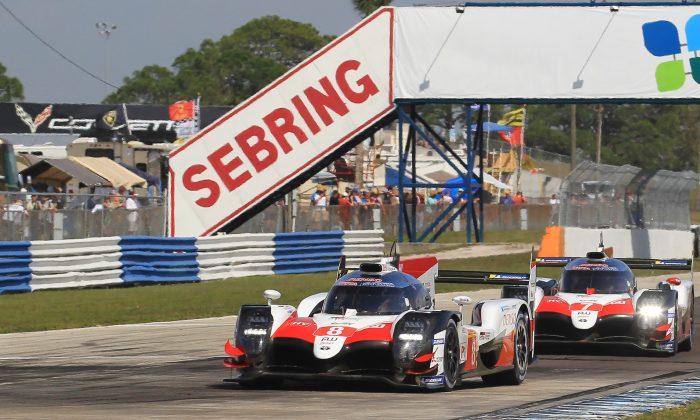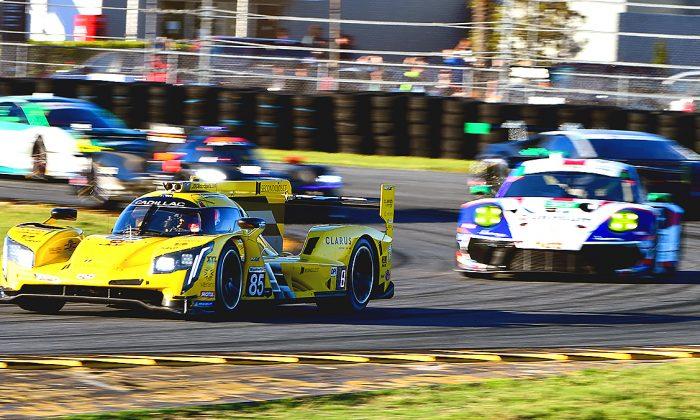The Tudor SportsCar Championship wanted to include historic Mazda Laguna Seca Raceway on its 2014 schedule, but the track and especially the pits were too tight for the series’ 60+ -car field.
TUSC found a solution: they divided the field in half, so the Pro-Am classes, Prototype Challenge and GT Daytona, would race for two hour in the afternoon, while the all-Pro Prototype and GT Le Mans classes would take over the track in the afternoon.
Thirty cars took the grid for the Pro-Am race: eight PCs and 22 GTDs, a larger field than the all-pro classes could muster.
The two-hour length presented some interesting strategy options. Everyone was sure there would be at least some time spent under caution, but how much? A PC car could expect to run less than 55 minutes on a tank of gas, a GTD maybe a few minutes more. Where the caution periods fell and how long they lasted would determine pit stop strategy.
Would it be better to stop after an hour regardless of when a car last stopped, or would it be better to risk running long, counting on a yellow flag late in the race? Could a set of tires last for two hours, or would a car make up the time spent changing tires with quicker lap times?
Starworks Takes its First TUSC Win
Starworks Motorsports was a top-tier team in the old Rolex Sports Car Series, but the departure of a driver with a lot of funding forced the team to cut its Prototype program back to one car. Team owner Peter Barron decided to expand into PC, where running costs were cheaper and chassis were plentiful.
Starworks entered a pair of PC Orecas at Laguna. The #7 car had a rotten day, getting hit in the morning warm-up and damaged so badly it couldn’t make the race. The #8, driven by Mirco Schultis and Renger van der Zande, more than made up for that loss.
The car started second behind the very quick RSR Racing Oreca of Duncan Ende and Bruno Junqueira, and just ahead of the also fast 8Star car of Luis Diaz and Sean Rayhall.
While all the “Am” drivers met the TUSC requirements for “Amateur” on a Pro-Am team, these are nonetheless some heavy hitters. The pros are serious pros: Bruno Junqueira is an IndyCar and sportscar veteran, and Luis Diaz co-drove to an ALMS P2 title with Adrian Fernandez in 2009.
As for the Ams, Duncan Ende started in Formula Atlantic and IMSA Lites in 2006, drove in the 2008 Rolex 24, and in the ALMS from 2010 to 2013. Sean Rayhall at 19 has nine years racing experience; he won the IMSA Lites championship in 2013 and also finished second at the ALMS Petit Le Mans that year—not exactly a weak link.
Ranged against them were 46-year-old Mirco Schultis and 28-year-old Renger van der Zande.
Schultis raced intermittently for several years starting in 2004 before winning the ELMS FLM championship (the European version of PC) with Pegasus Racing in 2011. He raced only 14 times in the next two years and scored a single podium.
Van der Zande is an open-wheel driver who has had only a few rides in sports cars, but he also had 25 wins in only nine years of racing prior to 2014.
The race did not begin well for the lone Starworks car. On lap 24, only 35 minutes into the race, Jon Bennett in the #54 Core Autosports car hit Schultis from behind, breaking the left rear legality piece (the “cheese wedge.”) The piece didn’t fall off, but it flapped and shook for the rest of the race.
This collision and the simultaneous but unrelated spin of the #46 Fall-Line GTD Audi brought out the race’s second yellow flag. The first had come only two minutes into the race and lasted only six minutes so it didn’t affect strategy. This second caution period, though, was right on the edge of the forty-minute minimum driver requirement, and just over the edge of a full fuel stint.
Almost the entire field headed for the pits as soon as they opened under yellow, which enabled the Starworks crew to check the car, swap van der Zande for Schultis, and get back out in fourth place. The Dutch driver pitted again with 50 minutes left, taking only right side tires to make the stop short, but he still dropped to sixth. He moved into third on lap 47—with 47 minutes left—when Gunnar Jeannette in the #52 PR1-Mathieson and Sean Rayhall in the #25 8Star pitted.
Bruno Junqueira in the #09 RSR Oreca and David Ostella in the #38 Performance Tech car were more than half a minute ahead of the field, but both owed a pit stop. Van der Zande set about chasing them, knowing that a run down pit lane would take more than half a minute; if he could cut into the lead, he could inherit first place when the two ahead made their stops.
Plans changed somewhat when on lap 62, with 27 minutes left in the race, David Ostella pushed too hard on old tires and slammed hard backward into the wall between Turns Seven and Eight. He broke the left rear suspension, but the car was drivable; he slowly headed back to the pits.
On his way through Turn Eight, the Corkscrew, Ostella was overtaken by a pair of GTD Porsches. The Performance Tech driver tried to cut in between the pair; the second car, the #58 Snow Pacing Porsche driven by Jan Heylen, apparently saw an opportunity to pass the other, one of the Muehlner Racing cars. Heylen tried to dive inside of Ostella, half on the dirt; he clipped Ostella and spun him.
Ostella came to a halt in the gravel on the right side of the road, his left rear wheel barely attached to the car. It seemed that the full-course caution the leaders had hoped for was about to come.
Instead, Ostella somehow managed to limp his crippled car just a few feet farther into the gravel to a safe parking spot, and TUSC officials, seeing that the car was out of the immediate impact area, decided not to go yellow.
It was too late for Bruno Junqueira; he had headed to the pits as soon as his team heard about the accident. His crew hoped to get him in before the yellow flag waved and the pits closed; if he had made it, he would have the race in the bag. Since the yellow never waved, he ended up making a green-flag stop and dropping to third, 15 seconds behind van der Zande, who now had the lead.
Van der Zande also had a charging Sean Rayhall in pursuit, and Rayhall had taken four tires on his last stop, so he had a better-handling car. The 8Star driver cut the lead to 3.8 seconds by lap 72, when his youthful enthusiasm got the better of him.
Rayhall came to the top of the Corkscrew together with a pair of GTD cars. The 8Star driver could have waited and passed them further down the track, but with only ten minutes left in the race, seconds counted.
Rayhall decided to go for it, trying to squeeze inside the two slower cars; he almost made it.
To his credit, Rayhall, when he realized he couldn’t get by, opted to turn tighter and spin rather than hit either of the two GTDs. The spin cost him, though; he lost several seconds, and any chance to win the race.
Van der Zande just had to keep control of the car, which was sliding at every corner with its two left-side tires totally shot, and he managed to do that, crossing the finish line 13 seconds ahead of Rayhall to bring Starworks its first win in PC and in 2014.
Junqueira got third for his efforts; he was only four-and-half second behind Rayhall at the finish.

Dane Cameron in the #94 Turner Motorsports BMW Z4 GT3 took the GTD class win in the TUSC Pro-Am Monterey Grand Prix. (Halston Pitman/MotorsportsMedia)
GTD: But for a Few Drops of Fuel ...
The GTD race was equally as exciting. Four cars fought for the lead throughout: the #45 Flying Lizards Audi of Neslon Canache Jr. and Spencer Pumpelly, the #94 Turner BMW of Markus Palttala and Dane Cameron, the #48 Miller Racing Audi of Bryce Miller and Christopher Haase, and the #22 AJR Porsche of Cooper MacNeil and Leh Keen.
As with the PC field, the GTD race didn’t really get tense until after the second yellow flag. The #45 Flying Lizard Audi and the #22 AJR Porsche were very quick; they opened enough of a gap over the field that both could start saving fuel. Both teams decided to try to do the entire race on a single stop, stretching the fuel and tires for over an hour.
Behind this pair, the Miller Audi and Turner BMW were on more normal strategies. Both pitted with about an hour to go; the BMW opted not to take tires while the Audi swapped all four.
It didn’t seem to matter; the leading pair ran flawlessly, and were far enough ahead that they could both focus on driving smoothly to save fuel. The laps ticked down, the race stayed green, and the #45 Audi and #22 Porsche cruised onward towards victory.
The pursuers didn’t ease off—the #94 BMW and #48 Audi pushed hard, determined to catch the leaders whether they had to pit or not.
The #22 AJR Porsche was first to run out of luck—the low-fuel warning went off six minutes from the finish and the car had to dive into the pits to prevent getting stuck on track, and fell to sixth in class.
Still the leading Flying Lizard Audi rolled, its engineers telling driver Spencer Pumpelly that his fuel numbers looked good and the car could make it. Pumpelly took the white flag with 16 seconds lead over Dane Cameron in the #94 BMW, who had Christian Haase on his wing.
Pumpelly made it to the top of the Corkscrew, with a fifty-foot drop in front of him—it must have looked as if he could coast to the win from there. Unfortunately, he could not. He lost fuel pressure right there; he rolled down through Turns Nine and Ten with no power, rolled to a stop, and had to sit helpless as the whole field streamed past him.

After leading more than half the race, Spencer Pumpelly in the #45 Flying Lizard Audi rolled to a stop a few hundred yards from the finish line. (Halston Pitman/MotorsportsMedia)
Cameron had to hold off Haase for one corner to take the class win. Haase had the handling, but Cameron had the position, and he held it. Haase finished second and Andy Lally in the #44 Magnus Porsche finished third, 12 seconds down.
TUSC heads to Detroit next for The Raceway at Belle Isle Park on May 31. This race will include the Prototype class and the GT Daytona class; GTLM and PC will sit this one out. Belle Isle is a bumpy street course that still manages to offer up some medium-speed corners; the newly balanced Daytona Prototypes and P2s should both have a shot at winning. In GTD, any one of a number of teams could win.
Visit IMSA.com for more info, or DetroitGP.com for tickets.





